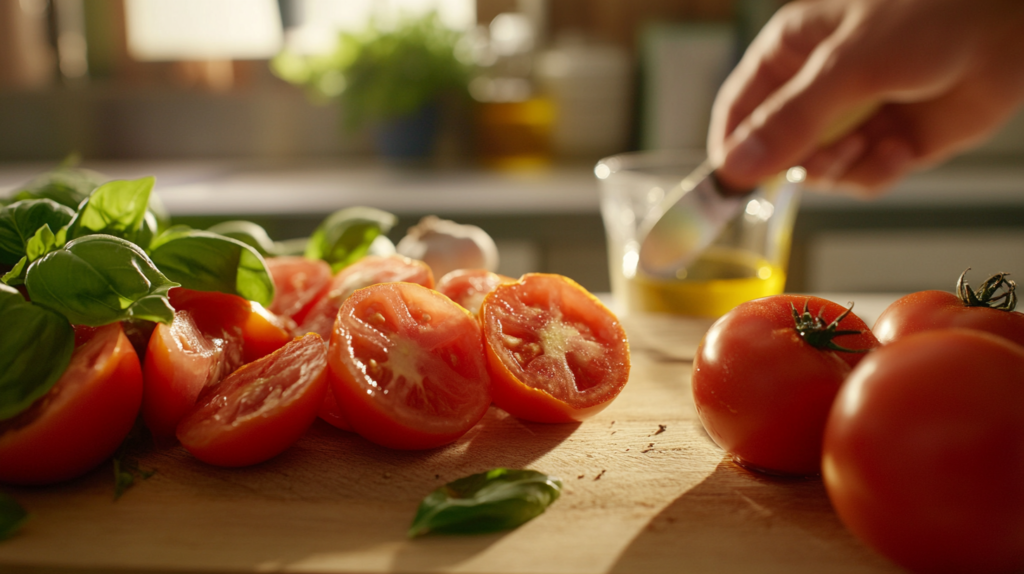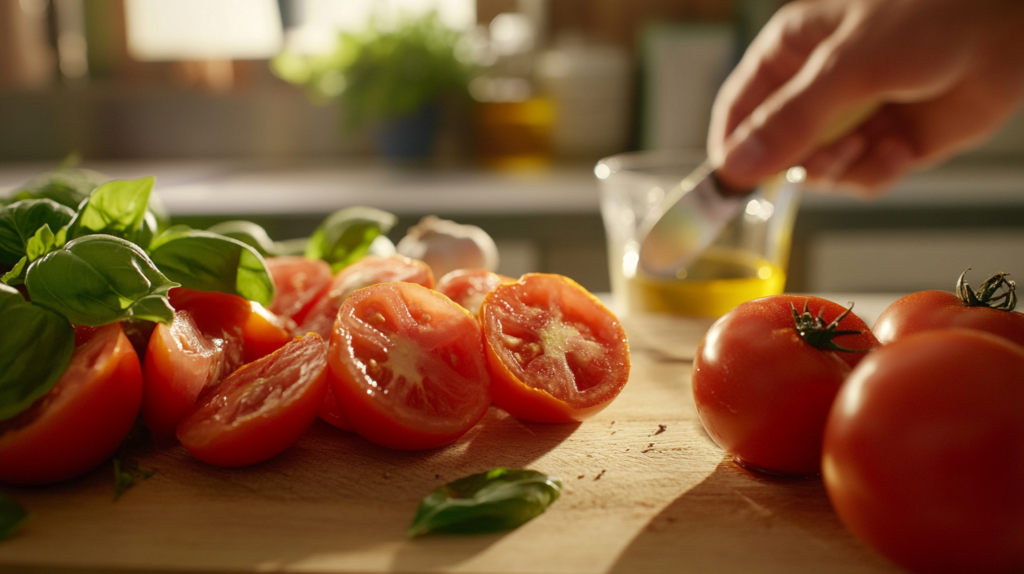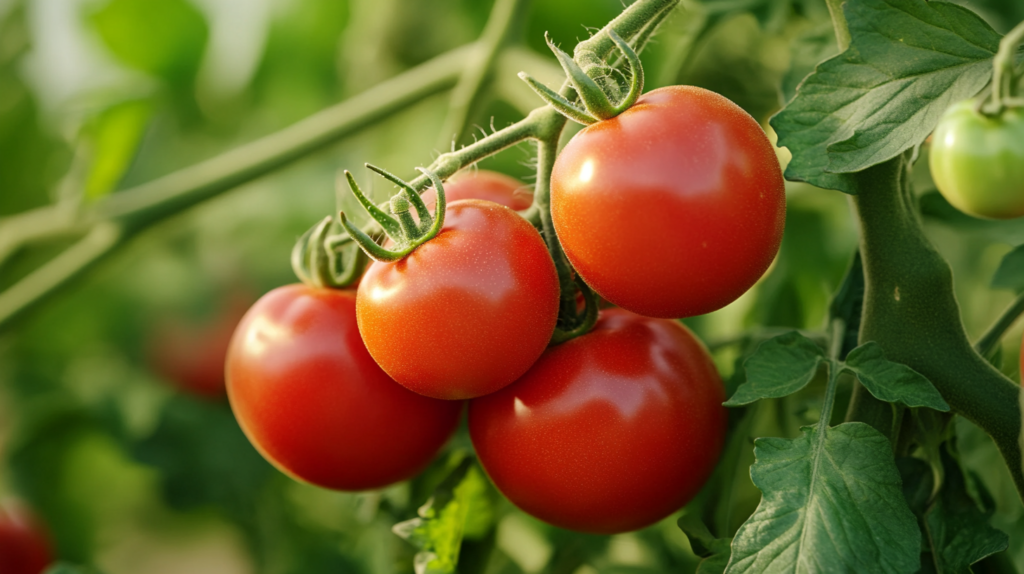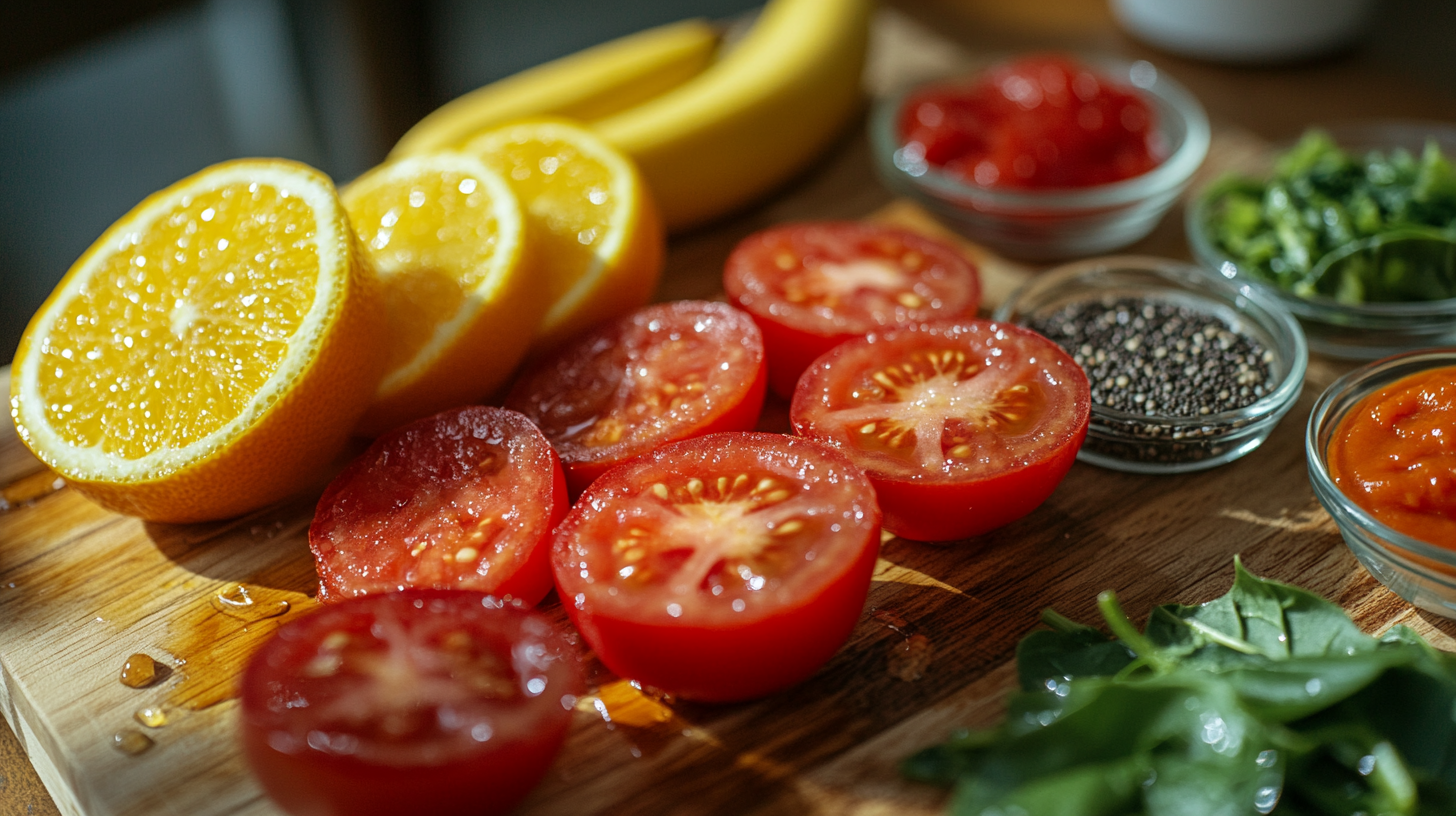Roma tomatoes are more than just a kitchen staple – they are packed with nutrients, antioxidants, and essential vitamins that support overall health. Whether you’re using them in salads, sauces, or soups, these small but mighty tomatoes provide numerous benefits. In this guide, we’ll explore everything you need to know about Roma tomato nutrition, from their macronutrients to their impact on heart health, digestion, and more.
Let’s dive into why Roma tomatoes deserve a spot in your daily diet!
Introduction to Roma Tomato Nutrition
What Are Roma Tomatoes?
Roma tomatoes, also known as plum tomatoes, are a variety of tomatoes known for their dense flesh, lower moisture content, and mildly tangy flavor. Unlike larger, juicier tomatoes, Roma tomatoes have fewer seeds and a firm texture, making them perfect for cooking.
They’re commonly used in sauces, salsas, pastes, and canned products because they hold up well during cooking. But besides their versatility, Roma tomatoes pack a serious nutritional punch.
Distinctive Features Compared to Other Tomato Varieties
What makes Roma tomatoes stand out? Compared to round or cherry tomatoes, they offer:
- Lower water content – ideal for making thick, rich sauces.
- More natural sweetness – balances out their acidity for a well-rounded flavor.
- Higher lycopene concentration – a powerful antioxidant with significant health benefits.
- Firm flesh and fewer seeds – making them easier to dice, chop, or cook.
So, whether you’re looking for a healthier pasta sauce or a nutrient-rich salad ingredient, Roma tomatoes are a perfect choice.
Macronutrient Profile of Roma Tomatoes
Understanding the macronutrient breakdown of Roma tomatoes can help you appreciate their role in a balanced diet. Let’s take a closer look at the caloric content, carbohydrates, protein, and fat in Roma tomatoes.
Calories and Serving Size of Roma Tomatoes
One of the best things about Roma tomatoes is their low-calorie content. A medium Roma tomato (about 60 grams) contains just 11-15 calories. This makes them an excellent choice for weight-conscious individuals or those looking to add bulk to meals without increasing calorie intake.
For a standard serving size of 100 grams, here’s what you get:
- Calories: ~18 kcal
- Carbohydrates: ~3.9g
- Fiber: ~1g
- Protein: ~0.8g
- Fat: ~0.2g
Carbohydrates: Natural Sugars and Fiber Content
Roma tomatoes contain about 3-4 grams of carbohydrates per 100-gram serving, most of which come from natural sugars and fiber.
Why does this matter?
- The fiber in Roma tomatoes helps support digestion and regulates blood sugar levels.
- Their natural sugars provide a mild sweetness without spiking insulin levels.
- Fiber also keeps you full longer, making them a great choice for weight management.
Protein Content in Roma Tomatoes
While tomatoes aren’t a major source of protein, they do contain small amounts (about 0.8 grams per serving). While this may not seem significant, it still contributes to your overall daily protein intake when combined with protein-rich foods like beans, chicken, or tofu.
Fat Content and Its Nutritional Impact
Roma tomatoes are virtually fat-free, containing less than 0.2 grams of fat per serving. This makes them an excellent choice for low-fat diets. Plus, their high water content (about 94%) makes them incredibly hydrating.

Essential Micronutrients in Roma Tomatoes
Beyond macronutrients, Roma tomatoes are loaded with essential vitamins, minerals, and antioxidants that contribute to overall health.
Key Vitamins: A, C, K, and Folate
Roma tomatoes provide a variety of important vitamins:
- Vitamin C: Boosts the immune system, promotes skin health, and aids in iron absorption.
- Vitamin A (Beta-Carotene): Supports eye health, improves skin elasticity, and boosts immunity.
- Vitamin K: Plays a crucial role in blood clotting and bone health.
- Folate (Vitamin B9): Essential for cell growth and development, particularly important for pregnant women.
Did you know? A single Roma tomato can provide up to 20% of your daily Vitamin C needs!
“Roma tomatoes are like little powerhouses of nutrition. They provide essential vitamins and antioxidants without excess calories, making them perfect for a healthy diet.”
Important Minerals: Potassium, Magnesium, and Iron
Roma tomatoes also provide key minerals:
- Potassium (250mg per serving): Helps regulate blood pressure and muscle contractions.
- Magnesium: Supports nerve and muscle function.
- Iron: Important for healthy red blood cells and preventing anemia.
Including Roma tomatoes in your diet ensures a steady intake of these essential nutrients.
Antioxidants: Lycopene and Beta-Carotene
Perhaps the most remarkable nutrient in Roma tomatoes is lycopene. Lycopene is a powerful antioxidant that gives tomatoes their red color and is known for its anti-inflammatory and heart-protective properties.
Health benefits of lycopene:
- Supports heart health by reducing bad cholesterol levels.
- Protects cells from oxidative damage, reducing the risk of chronic diseases.
- May help reduce the risk of certain cancers, including prostate and breast cancer.
Pro Tip: Cooking Roma tomatoes enhances lycopene absorption, making tomato sauces and soups an even healthier choice.
“Cooking tomatoes doesn’t destroy their nutrients—it actually makes some antioxidants, like lycopene, even more bioavailable for your body.”
How Roma Tomatoes Improve Your Health
Roma tomatoes aren’t just a delicious addition to your meals—they offer real health benefits. From supporting heart health to aiding in weight loss, these nutrient-packed tomatoes are a powerhouse of wellness. Let’s break down the specific ways Roma tomato nutrition can help improve your health.
Cardiovascular Benefits of Roma Tomatoes
H3: How Lycopene Supports Heart Health
One of the biggest health benefits of Roma tomatoes is their high lycopene content. Lycopene is a powerful antioxidant that plays a major role in heart health by:
Reducing bad cholesterol (LDL): High cholesterol levels increase the risk of heart disease. Lycopene has been shown to lower LDL levels, keeping arteries clear and reducing the risk of blockages.
Improving blood circulation: Lycopene helps keep blood vessels flexible, reducing the risk of high blood pressure and strokes.
Protecting the heart from oxidative stress: Free radicals can damage heart cells over time, but lycopene works as a shield, preventing oxidative damage and inflammation.
“Research suggests that a diet rich in lycopene-containing foods, like Roma tomatoes, may lower the risk of heart disease by up to 30%.”
Pro Tip: Cooking Roma tomatoes increases lycopene absorption! Eating them in sauces or soups can boost your heart-protective benefits even more.
How Potassium in Roma Tomatoes Helps Regulate Blood Pressure
Roma tomatoes are also rich in potassium, a key mineral that helps control blood pressure. Potassium works by:
Balancing sodium levels: Too much salt can cause high blood pressure, but potassium helps the body remove excess sodium through urine.
Relaxing blood vessels: Potassium helps reduce tension in blood vessel walls, improving circulation and lowering hypertension risks.
A 100g serving of Roma tomatoes contains about 250mg of potassium, making them an excellent choice for anyone looking to support their heart health naturally.
Roma Tomatoes and Weight Management
Low-Calorie and High-Fiber Benefits for Weight Loss
If you’re looking to shed a few pounds, Roma tomatoes should be your go-to ingredient. They are:
Low in calories – A medium Roma tomato contains only 15-18 calories, so you can enjoy them freely without worrying about your calorie intake.
High in fiber – Fiber helps keep you full for longer, reducing the chances of overeating. It also aids digestion and promotes a healthy gut.
Hydrating – Since Roma tomatoes are made up of 94% water, they help keep your body hydrated, which is crucial for metabolism and overall well-being.
How to use Roma tomatoes for weight loss:
- Add them to salads for a filling, nutrient-packed meal.
- Use them in soups and sauces for a low-calorie yet flavorful base.
- Eat them raw as a snack with a pinch of sea salt or a drizzle of olive oil.
“Roma tomatoes are an ideal food for weight management—low in calories, high in fiber, and packed with essential nutrients.”

Roma Tomatoes for Digestive Health
How Roma Tomatoes Help with Digestion and Gut Health
A healthy digestive system is key to overall wellness, and Roma tomatoes provide the right nutrients to keep your gut happy.
Rich in fiber: Roma tomatoes contain about 1 gram of fiber per 100g, which helps promote regular bowel movements and prevents constipation.
Supports gut bacteria: The fiber in Roma tomatoes serves as a prebiotic, feeding the healthy bacteria in your gut and supporting digestion.
Helps with acid reflux: Unlike some highly acidic tomatoes, Roma tomatoes have a balanced pH, making them gentler on the stomach for people prone to acid reflux or heartburn.
If you suffer from digestive issues, try eating Roma tomatoes in moderation and pairing them with healthy fats (like olive oil) to reduce acidity.
The Anti-Inflammatory Power of Roma Tomatoes
Inflammation is the root cause of many chronic diseases, including arthritis, diabetes, and heart disease. Roma tomatoes contain antioxidants and vitamins that help reduce inflammation naturally.
How Antioxidants in Roma Tomatoes Reduce Inflammation
Lycopene fights oxidative stress: This antioxidant protects cells from damage caused by free radicals, helping reduce inflammation.
Vitamin C supports the immune system: Roma tomatoes provide a natural dose of Vitamin C, which helps lower inflammatory markers in the body.
Beta-carotene improves skin health: This powerful compound supports cell regeneration and helps fight inflammation-related conditions like eczema and acne.
“A diet high in antioxidants, including Roma tomatoes, can help reduce the risk of inflammatory diseases and improve overall health.”
Pro Tip: If you want maximum anti-inflammatory benefits, eat Roma tomatoes with healthy fats (like avocado or olive oil) to increase nutrient absorption.
Roma Tomatoes and Their Cancer-Fighting Properties
Many studies suggest that the lycopene and antioxidants found in Roma tomatoes may help lower the risk of certain cancers.
Can Roma Tomatoes Help Prevent Cancer?
Lycopene helps protect cells: By neutralizing harmful free radicals, lycopene reduces DNA damage, which can lead to cancer cell formation.
Studies show a link to lower prostate cancer risk: Some research suggests that men who consume tomatoes several times a week may have a lower risk of developing prostate cancer.
Beta-carotene supports overall cell health: This antioxidant helps prevent abnormal cell growth, reducing the risk of cancers like lung and breast cancer.
“Regular tomato consumption has been linked to lower risks of prostate, lung, and breast cancer due to its powerful antioxidant content.”
While no single food can prevent cancer, a diet rich in antioxidants—like those found in Roma tomatoes—can significantly reduce overall risk.
How to Maximize the Health Benefits of Roma Tomatoes
Now that you know the benefits, how can you get the most out of Roma tomato nutrition?
Raw vs. Cooked: What’s Better?
Raw Roma tomatoes are best for preserving Vitamin C and fiber. Use them in salads, sandwiches, and fresh salsas.
Cooked Roma tomatoes enhance lycopene absorption, making sauces, soups, and roasted tomatoes a great way to boost antioxidant intake.
Pairing Roma Tomatoes with Healthy Fats
Lycopene is fat-soluble, meaning your body absorbs it better when eaten with healthy fats like:
- Olive oil
- Avocado
- Nuts and seeds
A simple tomato-avocado salad or olive oil-drizzled tomato soup is an easy way to boost absorption and maximize benefits.

Cooking with Roma Tomatoes: Unlocking Their Full Flavor
Roma tomatoes are known for their versatility in the kitchen. Their dense flesh and low moisture content make them ideal for a wide range of dishes, from fresh salads to rich pasta sauces. Whether you prefer them raw, roasted, or simmered into a hearty stew, Roma tomatoes bring a depth of flavor to every meal.
when fresh tomatoes are out of season.
Simple and Delicious Roma Tomato Recipes
Recipe 1 – Roma Tomato and Avocado Salad
Ingredients:
- 4 Roma tomatoes, sliced
- 1 ripe avocado, diced
- 1/4 red onion, thinly sliced
- 2 tablespoons olive oil
- 1 tablespoon lemon juice
- Salt and black pepper to taste
Instructions:
- Arrange Roma tomatoes, avocado, and red onion on a serving plate.
- Drizzle with olive oil and lemon juice.
- Season with salt and black pepper, then serve immediately.
This simple salad is perfect as a side dish or a light lunch.
Recipe 2 – Homemade Roma Tomato Marinara Sauce
Ingredients:
- 6 Roma tomatoes, diced
- 2 tablespoons olive oil
- 3 cloves garlic, minced
- 1/2 onion, finely chopped
- 1 teaspoon dried oregano
- 1/2 teaspoon salt
- 1/4 teaspoon black pepper
- Fresh basil for garnish
Instructions:
- Heat olive oil in a pan over medium heat. Add onions and cook until soft.
- Stir in garlic and cook for 30 seconds.
- Add diced Roma tomatoes, oregano, salt, and pepper. Simmer for 20-30 minutes, stirring occasionally.
- Blend for a smooth sauce or leave chunky for a rustic texture.
- Serve over pasta or as a base for pizza.
This sauce can be made in advance and stored in the refrigerator for up to five days.
Recipe 3 – Roasted Roma Tomato Soup
Ingredients:
- 6 Roma tomatoes, halved
- 1 onion, chopped
- 3 cloves garlic, whole
- 2 cups vegetable broth
- 2 tablespoons olive oil
- 1 teaspoon dried thyme
- Salt and black pepper to taste
Instructions:
- Preheat the oven to 400°F (200°C).
- Place Roma tomatoes, onion, and garlic on a baking sheet. Drizzle with olive oil and season with salt, pepper, and thyme.
- Roast for 30 minutes until caramelized.
- Transfer to a blender, add vegetable broth, and blend until smooth.
- Heat on the stove before serving.
A warm bowl of tomato soup is perfect for a cozy meal on a cold day.
Storage Tips for Keeping Roma Tomatoes Fresh
How to Store Roma Tomatoes at Room Temperature
If your Roma tomatoes are still ripening, keep them at room temperature away from direct sunlight. Place them stem side down to prevent bruising. Once ripe, they should be used within a few days.
Refrigerating Roma Tomatoes – Yes or No?
Refrigeration can alter the texture of Roma tomatoes, making them mealy and less flavorful. If you must store them in the fridge, allow them to return to room temperature before eating to restore some of their flavor.
Freezing Roma Tomatoes for Long-Term Use
Roma tomatoes can be frozen for later use in sauces and soups. To freeze:
- Blanch tomatoes in boiling water for 30 seconds, then transfer to an ice bath.
- Remove the skins, chop, and store in freezer-safe bags.
- Use within six months for the best quality.
Freezing Roma tomatoes is a great way to reduce waste and keep their nutrients intact.
More Fresh & Healthy Recipes to Try
If you love the rich flavor and health benefits of Roma Tomatoes, here are some other delicious and nutritious recipes you might enjoy:
- Try this Chicken and Shrimp Recipe for a protein-packed dish that pairs well with fresh tomatoes.
- Looking for a bold and zesty dish? This Buffalo Chicken Salad Recipe combines fresh ingredients with a spicy kick.
- If you enjoy fresh and creative ways to use ingredients, check out these Rice Paper Recipes for unique and healthy meal ideas.
- Want a vibrant and nutritious side dish? This Red Rice Recipe is packed with flavor and a great complement to any meal.
- For a light and healthy salad option, try this Chick-fil-A Kale Salad Recipe, a fresh and delicious dish packed with greens.
These recipes will help you make the most of nutritious, flavorful ingredients like Roma tomatoes. Try them out and enjoy every fresh and healthy bite!
Conclusion: The Power of Roma Tomatoes in Your Diet
Roma tomatoes are more than just a kitchen staple—they are a nutritional powerhouse that brings both flavor and health benefits to your meals. Whether eaten raw, roasted, or cooked into a sauce, these versatile tomatoes offer essential vitamins, minerals, and antioxidants that support your overall well-being.
One of the standout benefits of Roma tomatoes is their high lycopene content, an antioxidant linked to heart health, reduced inflammation, and cancer prevention. Their low-calorie, high-fiber profile makes them an excellent choice for weight management and digestive health.
In the kitchen, Roma tomatoes shine in everything from fresh salads and salsas to rich pasta sauces and hearty soups. Their dense flesh and natural sweetness make them a go-to ingredient for both home cooks and professional chefs. Whether you’re looking to add more nutrients to your diet or simply enjoy delicious meals, incorporating Roma tomatoes into your recipes is a simple and effective way to boost your health.
To maximize their benefits:
- Eat them raw in salads and salsas to retain vitamin C.
- Cook them into sauces and soups to enhance lycopene absorption.
- Preserve them through canning, freezing, or drying for year-round use.
By making Roma tomatoes a regular part of your meals, you can enjoy their unique taste, vibrant color, and impressive nutritional value every day. So next time you’re at the store or farmer’s market, grab a few Roma tomatoes and get creative in the kitchen—your health and taste buds will thank you!

